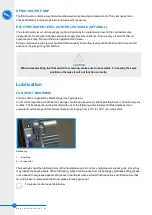
UNUSUAL NOISE AND VIBRATIONS
Unusual noise and/or vibration are the result of malfunctioning of mechanical components or operational problems
(e.g. unwanted ice formation). If this occurs, a thorough inspection of the entire unit followed by immediate
corrective action is needed. If required, consult your local BAC Balticare representative for assistance.
Inspections and corrective actions
GENERAL CONDITION OF THE EQUIPMENT
The inspection should focus on following areas:
•
damage of corrosion protection
•
signs of scale formation or corrosion
•
accumulation of dirt and debris
•
presence of biofilms
Smaller damages of the corrosion protection MUST be repaired as soon as possible to prevent the damage from
getting bigger. For Baltibond
®
hybrid coating use kit (part number RK1057). Larger damages should be reported to
the local BAC Balticare representative.
If there is evidence of scale formation (more than 0,1 mm) or corrosion, water treatment regime must be checked
and adjusted by the supplier.
Any dirt and debris need to be removed following the "Cleaning procedures" on page 27 .
If there is evidence of biofilms the system, including piping should be drained, flushed and cleaned of slimes and
other organic contamination. Refill system with water and apply biocide shock treatment. Check pH value and
functionality of ongoing biocide treatment.
HEAT TRANSFER SECTION
The inspection procedure is as follows:
1. Shut off fan(s) and pump(s).
2. Remove the eliminators and access doors.
3. Inspect the coil for
-
obstructions
-
damages
-
corrosion
-
fouling
4. After inspection, install eliminators and access doors and start pump(s) and fan(s).
Remove any obstructions from heat transfer section(s).
Any damages or corroded areas need to be repaired. Call your local BAC Balticare representative for assistance.
Minor fouling can usually be removed chemically or by temporary changes to the water treatment programme.
Contact your water treatment supplier for advice. Major fouling requires cleaning and flushing according to the
"Cleaning procedures" on page 27 .
Regular checking of the total aerobic bacteria count (TAB) and maintaining it within acceptable levels are the key
to prevent fouling.
DRIFT ELIMINATORS
The inspection procedure is as follows:
1. With fan(s) and pump(s) running visually check for areas with excessive drift loss.
2. Shut off fan(s) and pump(s) and visually check eliminators for
-
obstructions
-
damages
-
cleanliness
-
proper fit
W W W . B A L T I M O R E A I R C O I L . E U
24

























